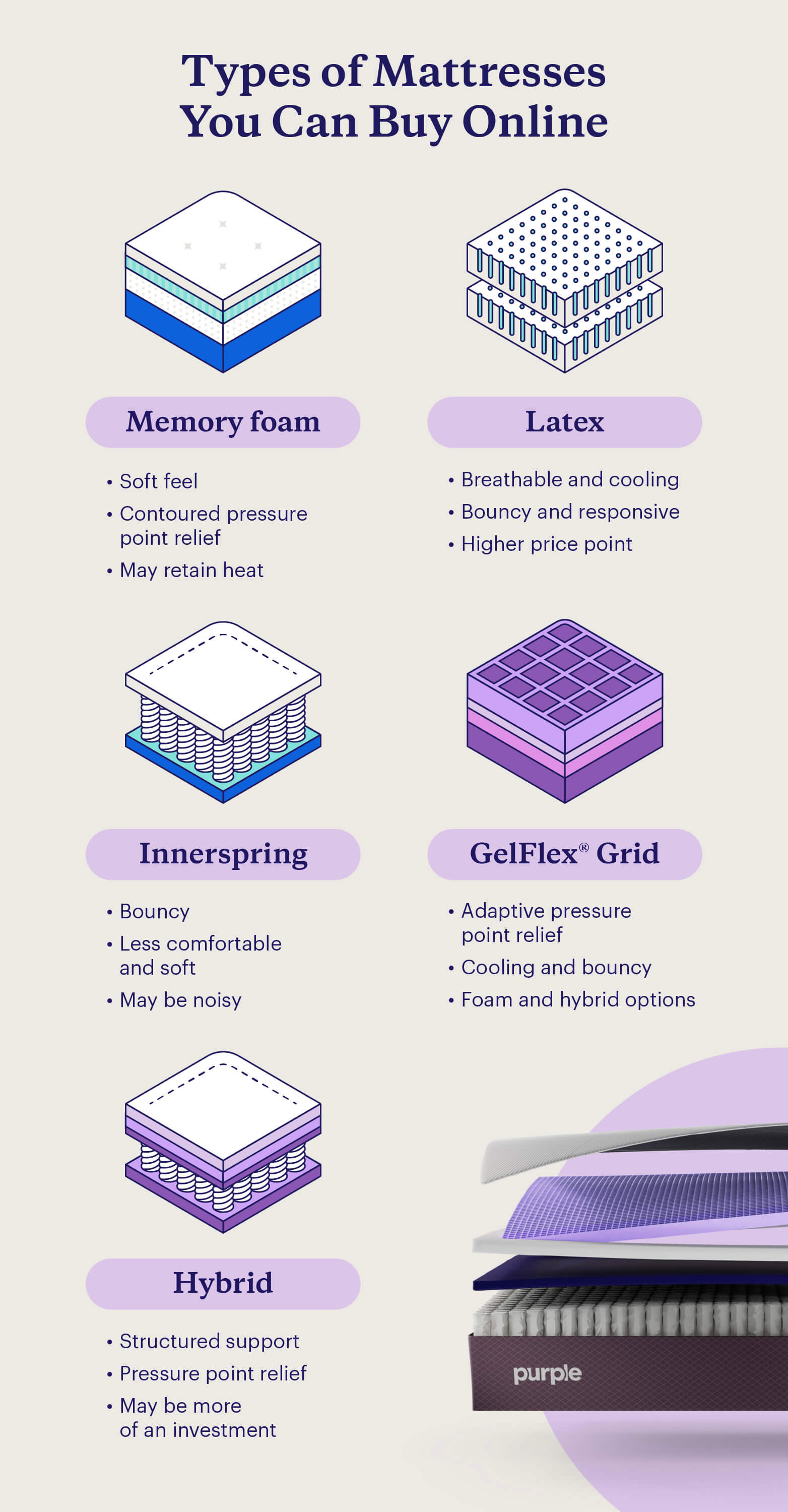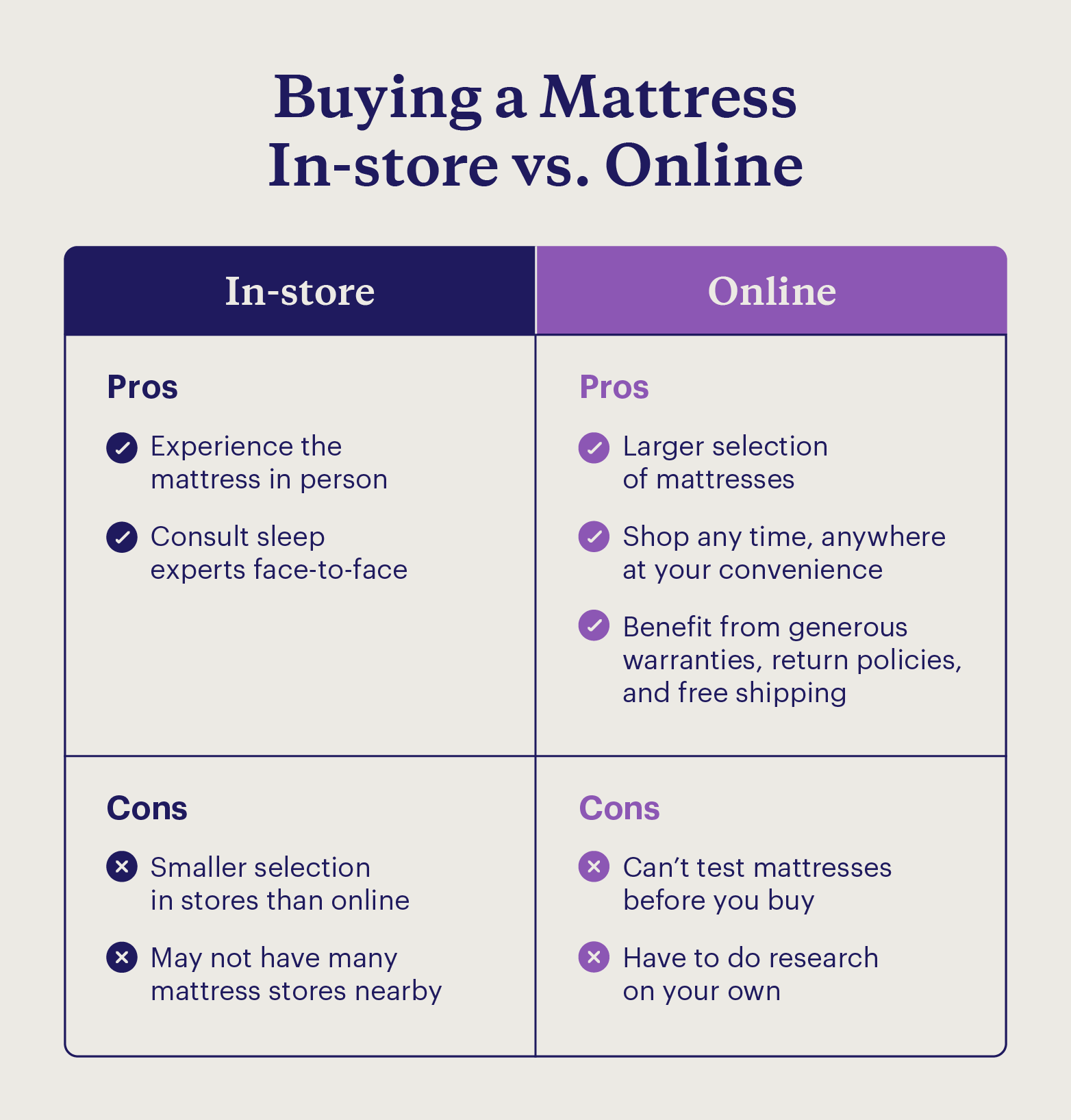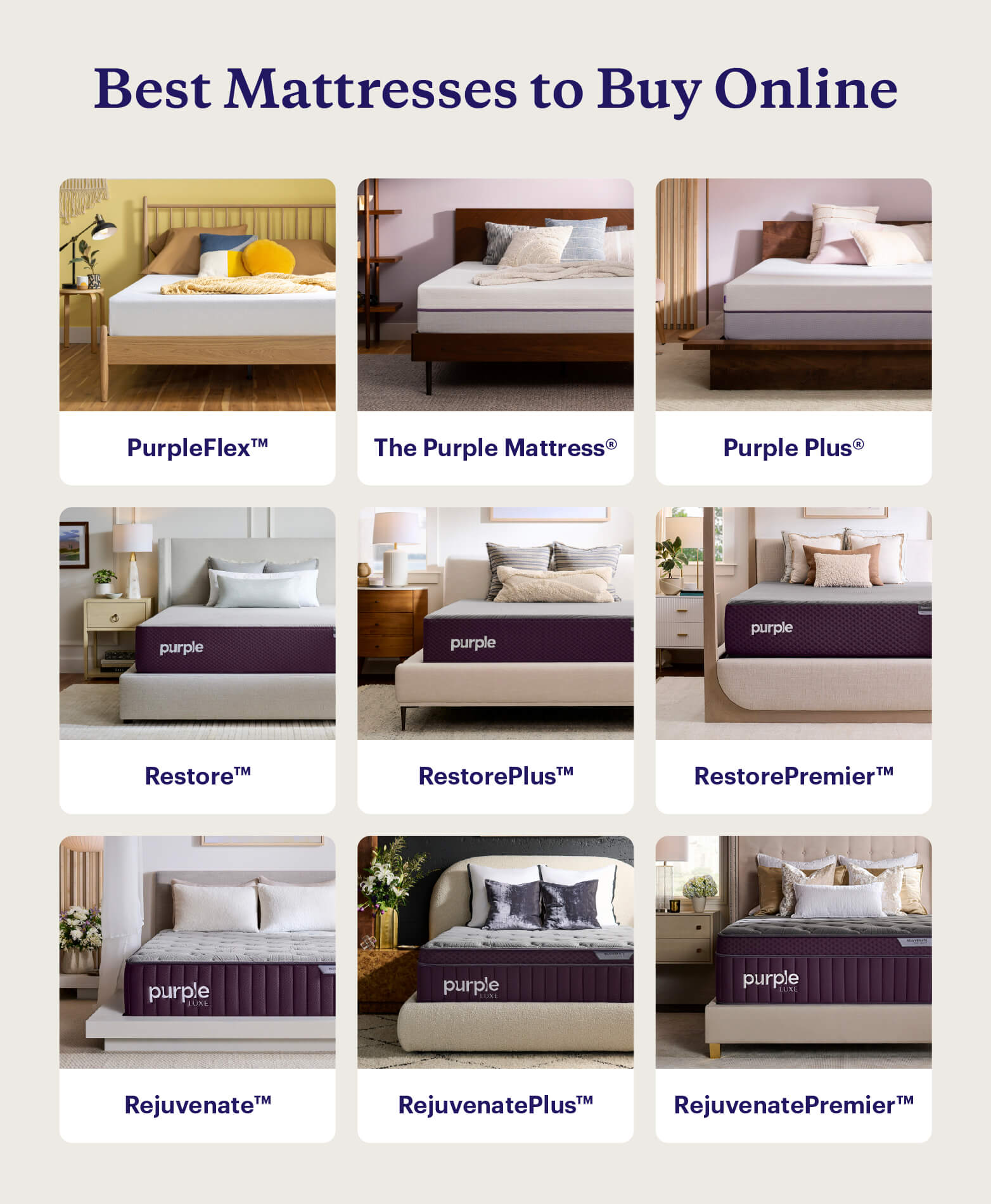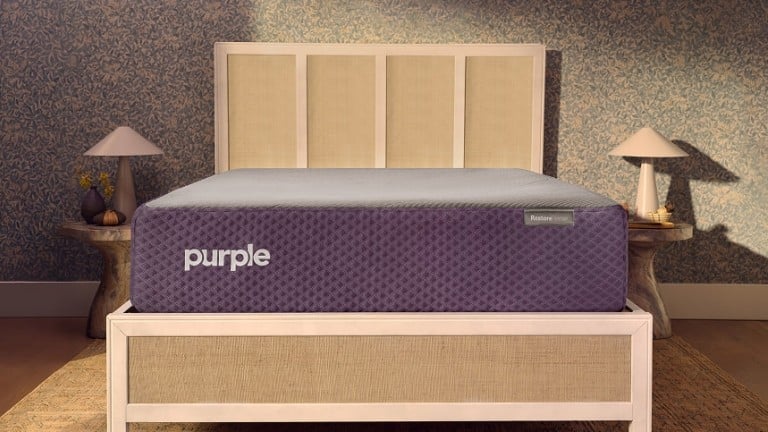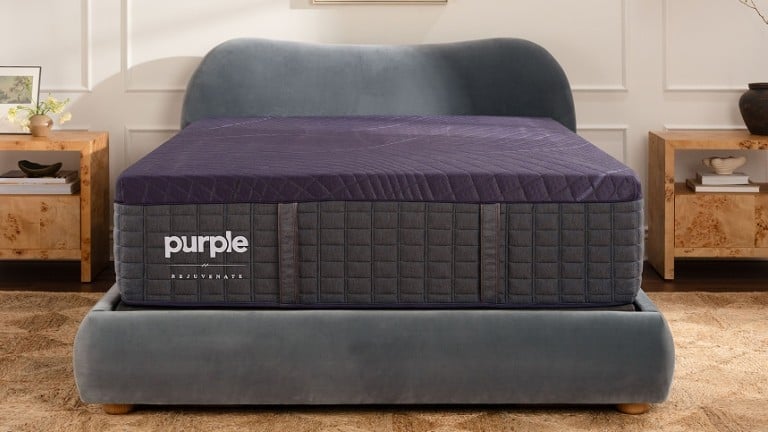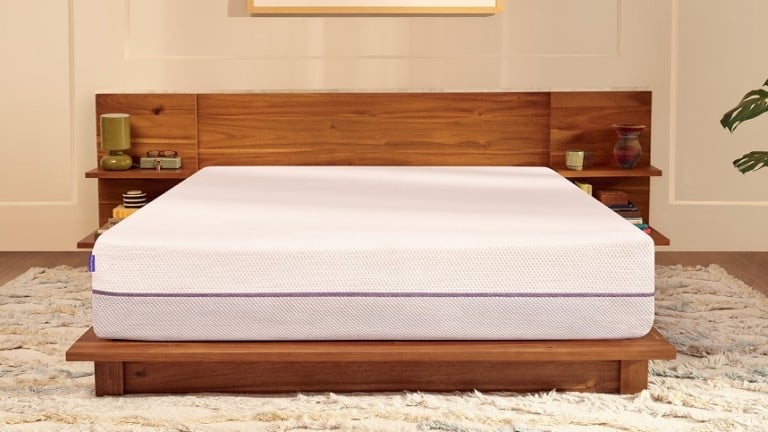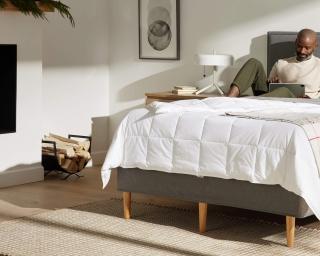
How To Buy a Mattress Online With Confidence in 9 Steps
What is the best way to buy a mattress?
- Buying a mattress online is a convenient and relatively low-risk process.
- Before buying a mattress online, consider your sleep preferences, the size and type of mattress you need, your preferred firmness level, and your budget. You can also test the mattress in a store to get a feel for its comfort before making a decision.
- Online mattress retailers like Purple offer competitive warranties, sleep trials, return policies, and free shipping to help customers feel more confident.
Nothing beats the convenience of online shopping, but for items like mattresses, shopping online may feel daunting. Learning how to buy a mattress online starts with identifying your needs and preferred sleep orientation. No matter your sleep position, you can find the best mattress for side sleepers or back sleepers online when you know what to look for.
In this guide, we’ll show you how to shop for the best online mattresses in nine easy steps. Keep reading to discover how to make informed decisions when buying a mattress online and what sets it apart from in-store shopping.
1. Determine the Right Mattress Size
Mattress sizes are often fairly straightforward, but choosing the right size for your needs requires some thought. Consider the following factors to help you decide which size bed best fits your needs.
- Number of sleepers: Will you be sharing this mattress or using it alone? Consider how much space all sleepers require to choose a mattress to properly accommodate your needs. For example, queen mattresses are the most popular bed size for couples.
- Height and body type: Look for a mattress that is long, wide, and supportive enough for your height and weight.
- Room size: Make sure the mattress fits in your room, leaving enough space for other furniture and unobstructed movement.
- Moving plans: Consider if you'll be moving soon, as larger mattresses are harder to relocate. Planning ahead can help reduce the hassle.
Size | Dimensions | Minimum room size | Best for |
Crib/toddler | 28-by-52” | 7-by-7’ | Babies and toddlers |
Twin | 38-by-75” | 7-by-9.5’ | Children, some teens, adults under 5’9” |
Twin XL | 38-by-80” | 8-by-10’ | Teens, young adults, and single adults under 6’2” |
Full | 54-by-75” | 9-by-9.5’ | Single adults under 6’2” |
Queen | 60-by-80” | 10-by-10’ | Adults and couples under 6’2” |
King | 76-by-80” | 11-by-11’ | Couples under 6’2” and adults who co-sleep with a kid or pet |
California king | 72-by-84” | 11-by-11’ | Couples under 6’6” and adults who want extra legroom |
Once you determine what size bed you should get, it’s easier to filter options online and find mattresses, bedding, and bed accessories in your preferred size.
2. Consider Your Sleep Needs and Preferences
Another aspect to consider when buying mattresses online is your unique sleep needs and preferences. Here are some factors to take into account when navigating how to buy a mattress online:
- Sleep position: The position you spend the most time in may affect the type of mattress and firmness level that provides the most support and comfort.
- Temperature: If you tend to sleep hot, you may want to buy a mattress with cooling features like our GelFlex Grid®, which doesn’t trap heat and helps you stay comfortable.
- Support: Do you prefer a mattress that cradles you or a more rigid mattress that keeps your spine aligned? Consider what feels most comfortable to determine your preferred level of support.
- Pain relief: Look into mattresses that provide proper back support or other specific areas of concern for options that provide the most relief where you need it most.
Identifying what you want out of your mattress can help you narrow down your options and shop for specific qualities, like the best cooling mattresses or mattresses that provide targeted pressure point relief.
3. Choose Your Optimal Firmness
The right mattress firmness for you varies depending on your body type, preferences, weight, and sleep position. Most people don’t spend all night in the same position, but if you know what feels most comfortable, you can choose a mattress that provides optimal support and pressure point relief in the areas you need it most.
If you’re not sure what mattress firmness to get, you can try mattresses in-store to get a sense of how different firmness levels actually feel. While many mattresses fall in the middle of the spectrum, you should still consider how a softer or firmer mattress affects airflow and temperature if you tend to sleep hot.
All Purple mattresses offer superior support and pressure relief across a range of firmness feels to best accommodate different sleep needs.
Firmness | Description | Best for |
Extra soft | Deep sinkage, contoured feel | Primarily side sleepers |
Soft | Some sinkage, contoured feel | Primarily side sleepers |
Medium soft | Some sinkage, good pressure point relief | Combination sleepers |
Medium | Less sinkage, good contouring | Combination sleepers |
Medium firm | Aligns the body with cushioning pressure relief | Combination sleepers |
Firm | Minimal sinkage and contouring | Primarily back and stomach sleepers |
Extra firm | More rigid, with basically no pressure point relief | Primarily back and stomach sleepers |
4. Determine Possible Mattress Types
Each type of mattress offers different benefits and requires unique considerations. Because sleep needs and preferences vary, it’s important to choose a mattress that has the features you need.
The most common types of mattresses include:
- Memory foam: Mattresses made with memory foam are often on the softer side since they’re designed to contour to your body. They often have low motion transfer and provide pressure point relief, but may offer limited enough bounce and retain heat.
- Latex: Breathable and responsive, latex mattresses are a good alternative to memory foam, especially for sleepers who want a cooler surface. Latex mattresses tend to have a higher price point than polyfoam mattresses.
- Innerspring: Innerspring mattresses once dominated the market but are less common now. They feature coils or springs at the core for a bouncier, firmer feel, but they can be less comfortable than other options.
- GelFlex Grid®: Purple mattresses are in a league of their own, featuring our proprietary GelFlex Grid®, a hyper-elastic polymer comfort layer that instantly adapts to your body and keeps you cool with plenty of bounce and low motion transfer. Purple offers GelFlex Grid® mattresses with foam and hybrid options to meet your unique sleep needs.
- Hybrid: Hybrid mattresses combine the structure of an innerspring mattress with comfort layers, making them a luxurious option that provides support and pressure point relief. Mattresses like Purple’s Restore® Hybrid Collection are great for various body types and sleep styles, though they may be more of an investment.
The best mattress is one that provides the support and comfort you need. Compare the pros and cons of each type before buying a mattress online to make sure you get the features that will help you sleep better.
5. Consider Material Sources and Certifications
When choosing an online mattress, reviewing the materials used and their certifications can help you compare mattresses and ensure their safety. Reputable certifications like CertiPUR-US®verify that foam components are free from harmful chemicals, while OEKO-TEX® certifies textile safety.1,2
Purple’s non-toxic mattresses are proudly made in the U.S., using domestically sourced CertiPUR-US® certified materials alongside some imported components. This commitment to quality and transparency helps distinguish reputable online mattress brands from less reliable options, giving you peace of mind about the materials supporting your sleep.
6. Set Your Budget
Mattresses range from as low as $700 to over $10,000. Determine how much you should spend on a mattress by considering the following factors that can affect mattress price:
- Bed size: Twin and kid mattresses cost less than double beds but offer less room for sleepers.
- Type of mattress: Innerspring mattresses are often more affordable than other types of mattresses, but may not be comfortable or supportive enough for everyone.
- Mattress quality: How well a mattress is constructed affects its durability and longevity. High-quality mattresses are often more expensive than poorly constructed ones.
- Mattress features: Features that provide cooling, targeted pressure point relief, added edge support, and other benefits may increase the cost of a mattress but make it more comfortable, durable, and supportive.
- Where you buy: Online mattress retailers often cover shipping costs, provide long sleep trials, and offer frequent discounts on individual mattresses.
While price is an important consideration, it’s essential to invest in a quality mattress that will support your sleep needs and last for years. Don’t just opt for the cheapest option. Look for something that offers durability and comfort.
If cost is a concern, explore pay-later options and other funding methods. You can even buy a mattress with a health savings account (HSA) or FSA if you meet certain qualifying criteria to reduce the upfront financial strain.
7. Read Online Mattress Reviews
If you’re wondering how to buy a mattress online that will make your investment worthwhile, be sure to read mattress reviews for the options you’re considering. You can look for what people like and don’t like to inform your decisions.
Reviews may also mention how different mattresses have affected other people’s sleep quality. If you experience localized pain, have sleep apnea, or tend to sleep hot, looking for relevant topics in reviews can help you narrow down the highest-rated online mattress that could benefit your specific needs.
8. Understand Shipping, Return, and Warranty Policies
Buying a mattress online means taking advantage of the policies and perks online mattress companies have to offer. Before you buy a new mattress, look for the following policies to guide your choice:
- Shipping: If you buy a mattress online, you’ll likely get free shipping. This is most common for brands that sell mattresses in boxes or roll their mattresses for compact shipping.
- Return policies: Most online sellers understand that there’s some risk in ordering a mattress online without getting to test it out. Companies often offer easy return policies to ensure you get a mattress you love.
- Sleep trials: You may not know if a mattress is right for you after a single night, and online sellers usually offer a sleep trial so you can return or replace your mattress if it’s not a good fit. Purple offers a 100-night sleep trial for all mattresses.
- Warranties: A warranty is a guarantee from the manufacturer that, if you follow care instructions, it will stay in good condition for a certain number of years. Warranties also tell you what kind of damage may be covered.
9. Decide When To Buy a New Mattress
Timing your purchase can help you save money because many brands offer sales during holiday weekends, seasonal promotions, or clearance events. That doesn’t mean you have to wait for a sale to change your mattress.
If your current mattress is causing discomfort, pain, or sleep disruptions, it’s likely due for a change. Remember, the best time to buy a mattress is when you’re experiencing poor sleep quality or your mattress shows signs of wear, even if it means purchasing outside of big sale periods.
Additional Considerations for Buying a Mattress
Knowing how to pick a mattress online means considering more than just firmness level and budget. You must factor in delivery logistics and accessories. Here are additional considerations to keep in mind:
- Bed foundation: Choosing the right type of bed foundation ensures proper support and a correct fit for your mattress, which can enhance comfort and extend its overall longevity.
- Bedding: Investing in quality bedding, including mattress protectors, can improve comfort, protect your mattress, and contribute to better sleep hygiene.
- Delivery services: Consider delivery options that include mattress disposal services or white-glove delivery for a hassle-free setup and removal of your old mattress.
- Path clearance: Measure doorways, hallways, and stairways to ensure your mattress size and thickness can easily pass through without issue.
What To Do If You Can’t Decide Which Mattress To Buy
If you're unsure which mattress is best for you, consider taking online mattress quizzes to identify your ideal sleep needs. Visiting a showroom to test different models can also help you gauge comfort and support firsthand. Reading reviews and comparing features are additional ways to refine your options.
These steps can simplify the decision-making process and ensure you choose a mattress that aligns with your preferences and sleep style.
Buying a Mattress Online vs. In-Store
Buying a mattress online may be more convenient than shopping in-store, but there’s more to consider before you buy. The biggest downside is that you don’t get to test out the mattress beforehand. Sleep trials can help with that, since you’ll be able to try your new mattress for a few weeks or months before deciding whether you want to keep it or not.
If you have the time, you can find a mattress store near you and test how different mattresses feel. This is not a good indicator of how it will feel over time, however, since the mattress's feel may shift the longer you sleep on it and break it in. Additionally, moving your mattress can be a logistical concern, a factor that online shopping helps you avoid.
Benefits | Considerations | |
Online | Wide selection Generous sleep trials and return policies Free shipping and delivery Convenient Frequent sales and discounts 24/7 access to virtual sales representatives | Research required No testing before buying |
In-store | In-person sales representatives Ability to feel the mattress before buying | May have a smaller selection Fewer discounts May have to transport the mattress home yourself or pay for shipping |
Best Mattresses To Buy Online
The number of mattresses available online can feel overwhelming, and deciding which mattress is best for you often takes time and research. It’s important to find a mattress with features that meet your needs and preferences.
All Purple mattresses feature our proprietary GelFlex Grid®, which provides instantly adaptive support, contours to your body, and promotes airflow to keep you cool. You can purchase all of the following Purple mattresses online, and our sleep experts are always available to help you make a more informed decision:
- PurpleFlex®: Durable Base Foam adds support to our GelFlex Grid® at a convenient price. Available online only.
- The Purple Mattress®: Paired with Comfort Foam and durable Base Foam, our GelFlex Grid® provides pressure relief, support, and adaptive comfort.
- Purple Plus®: Ultra Comfort Foam and double the amount of Base Foam works with the GelFlex Grid® to cradle your pressure points, support your spine, and keep you cool and comfortable.
- Restore® Hybrid: Enjoy responsive support from Edge-to-Edge Coils and cooling, adaptive comfort with the GelFlex Grid® in our original hybrid mattress.
- RestorePlus® Hybrid: Get uninterrupted sleep with Ultra Comfort Foam, Edge-to-Edge Coils, and our adaptive, comfort-boosting GelFlex Grid® in this hybrid mattress.
- RestorePremier® Hybrid: Get the most out of your sleep with our enhanced hybrid mattress, featuring Coolflex™ Coils and the GelFlex Grid® for dynamic, cooling support and Ultra Comfort Foam for breathability and pressure point relief.
- Rejuvenate®: One of the best mattresses for adjustable beds, this luxurious option combines layers of DreamLayer™ Technology with 2-inch GelFlex Grid® and Firm Slow Response Foam to keep you cool, comfortable, and supported all night long.
- RejuvenatePlus®: Deeper 3-inch GelFlex Grid® support paired with DreamLayer™ Technology provides enhanced pressure relief and spinal alignment in a medium feel.
- RejuvenatePremier®: Soft adaptive foam complements dual layers of 2-inch GelFlex Grid® and DreamLayer™ Technology for a soft, supportive mattress you’ll love.
- RejuvenateUltimate™: Maximize your sleep quality and comfort with the immersive, luxurious comfort of DreamLayer™ Technology, combined with 3-inch and 2-inch GelFlex Grid® layers, and Slow Recovery Foam.
What Is the Best Online Mattress Company?
Now that you know how to buy a mattress online, it’s time to choose a reliable company to purchase from. With so many options available, choosing a trusted brand can make all the difference.
Purple is the best place to buy a mattress online. Our high-quality mattresses are made with CertiPUR-US® certified materials, featuring the innovative Purple Grid instead of a traditional memory foam for better bounce and airflow. These mattresses come with a generous sleep trial, free shipping, and a strong warranty program.
Compare our mattresses and find the best online bed for your needs. If you prefer in-store shopping, use our store locator to try Purple mattresses in person!
FAQ About Buying a Mattress Online
There are several advantages to buying a mattress online, including:
- Convenience: You can shop and order a mattress no matter where you are or what time it is.
- More options: You’ll have many more options online than in a store, so you can find a mattress that works for you.
- Free shipping: When you order a mattress online, you’ll usually get free shipping and delivery services.
- Sleep trials: Most online mattress brands offer sleep trials that allow you to test out your mattress and see if it’s a comfortable match.
No matter where you buy your mattress, make sure you do your homework ahead of time. If you’re worried that a mattress you bought online may not be comfortable at first, learn how to break in a new mattress to make sure you can sleep well.
Before you buy a mattress, you should make sure you have an idea of the mattress type, size, and feel you want. Ask yourself the following questions to help inform your decision.
- What size mattress do I need? It’s important to get the right size when you order, because some retailers won’t allow you to make an exchange for a different size. When choosing a mattress size, consider your bedroom size and your height. For example, if your room can only fit a twin-size mattress but you are taller than 5 feet 9 inches, a twin XL mattress might be best for you.
- What mattress firmness is right for me? How firm you need your mattress to be will depend on how much support you need. A firmer mattress may promote better spinal alignment for some sleepers, but can lead to pain and discomfort as well.
- Am I sharing this mattress with someone else? If you share a mattress with someone else, you’ll need a bigger mattress with equal weight distribution and motion isolation.
- How much can I afford to spend on a new mattress? Don’t go for the cheapest mattress you find, as you might sacrifice quality. Remember, a good, supportive mattress is an investment. Set your budget according to the features you want to prioritize.
- What do I like about my current mattress, and what would I change? Your current mattress can be an excellent benchmark for what you should look for next. Note features about your existing mattress that you want to keep as well as those you would like to improve.
Your ideal mattress depends on your physical needs and preferences. You’ll know a mattress is right for you if:
- It suits your budget: Mattresses can cost anywhere from a few hundred dollars to more than $10,000, with prices varying according to mattress type and features. As a rule of thumb, don’t go for the cheapest mattress you find. Cheaper mattresses are not very durable, but a higher price doesn’t necessarily mean better quality.
- It supports your ideal sleeping position: A good mattress should support your sleeping preferences. Back sleepers may prefer a medium to medium-firm mattress that keeps their spine aligned, while side sleepers may prefer a softer mattress that cushions their pressure points.
- It’s the right size: Bigger mattresses are not necessarily more comfortable, especially if you aren’t sharing them with someone else. Make sure your new mattress will fit in your space by measuring your room and comparing the measurements of the mattress.
- It provides optimal sleeping temperature: Memory foam may be too hot for some sleepers, while latex mattresses can provide ample cooling.
The best online mattresses are those that combine positive reviews, strong policies, and innovative sleep technology backed by research. Look for:
- High customer ratings and detailed reviews
- Generous sleep trials and warranty policies
- Certifications like CertiPUR-US® or OEKO-TEX®
- Advanced features such as adaptive support and cooling technology
Purple checks all these boxes with its proprietary GelFlex Grid®, excellent reviews, and transparent policies. If you’re wondering where to buy mattresses online, Purple is a leading choice for quality and reliability.
To evaluate mattress reviews and durability, look for detailed feedback from verified buyers and consider long-term performance reports. Choose the highest-rated online mattress, as it often indicates excellent quality, support, and durability backed by real user experiences.
On average, you should expect to replace your mattress after seven to 10 years. But you may need to buy a new mattress sooner if you experience any of the following:
- Your mattress is sagging or warping
- You’re waking up with new aches and pains
- Your mattress has stains, rips, or other signs of wear and tear
- Your allergies have gotten worse
- You don’t wake up feeling refreshed
- Your mattress has a bad odor
- Your mattress is squeaky or creaky
You should rule out other potential causes of these symptoms before blaming your mattress, but if your bed isn’t helping you feel well-rested, it may be time to purchase a new one.
Depending on the mattress, the setup process may vary. In most cases, these are the steps to set up your mattress.
- Unboxing: When you order a mattress online, it may come vacuum-sealed in a box or other compact package. Open the package according to instructions to avoid damaging the mattress.
- Positioning: Place your mattress on your bed frame or foundation and lay it out by unrolling or unfolding it.
- Blooming: After being compressed, your mattress needs time to bounce back. The blooming process can take anywhere from four to 24 hours.
- Bedding: Once your mattress has fully expanded, you can put your bedding on it and enjoy your first night on your new mattress.
More To Explore
Level up your sleep routine with our most-loved products.


